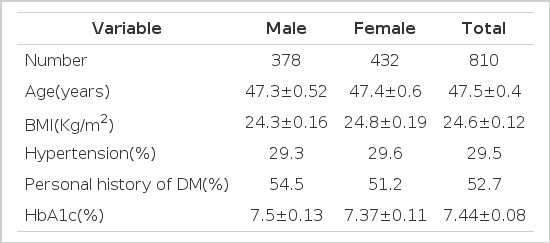New ADA Criteria in the Korean Population: Fasting Blood Glucose is not Enough for Diagnosis of Mild Diabetes Eespecially in Theelderly
Article information
Abstract
Background
To compare the 1997 American Diabetes Association (ADA) criteria with the 1985 World Health Organization (WHO) criteria in categorization of the diabetes diagnostic status of Koreans and to define clinical characteristics of subjects diagnosed differently by the two criteria.
Methods
In 810 Korean subjects, we analyzed blood glucose and insulin response during 75 g oral glucose tolerance test (OGTT). According to current WHO criteria, the cutoff values of FPG which distinguish normal and IGT from diabetes were determined. Then the subjects were categorized according to both WHO and ADA criteria. The clinical characteristics of the subjects with different diagnostic categories by the two criteria were defined.
Results
The FPG cut point distinguishing diabetes from IGT was 117 mg/dl, and from normal was 110 mg/dl. The overall agreement between the ADA criteria and the WHO criteria was moderate, as reflected in the κof 0.45. 141 of subjects categorized diabetes by WHO criteria were not diagnosed with ADA criteria. These discordant subjects were older in age and showed blunted early insulin response than concordant normal subjects.
Conclusion
These results suggest that mild diabetes by the WHO criteria, especially in the elderly, would not be diagnosed as diabetes by the ADA FPG criteria only. Thus, in a group at high risk for developing diabetes or in a relatively older age group, we should continue using the OGTT.
INTRODUCTION
In 1997, the ADA recommended revised diagnostic criteria for diabetes. The NDDG or WHO diagnostic criteria was criticized for discrepancy between fasting plasma glucose (FPG) value and 2 hour post-glucose load plasma glucose (2-h PG) value1–4). To improve validity, the ADA reduced FPG cut off criteria to 126 mg/dL (7.0 mmol/L) as diagnostic FPG for diabetes. The new diagnostic category, impaired fasting plasma glucose (IFG), was created as an intermediate group corresponding to IGT of NDDG criteria. The oral glucose tolerance test, considered the gold standard diagnostic test by NDDG or WHO criteria, was not recommended for routine clinical use any more5). However, in a number of studies, lower FPG value than 7.0 mmol/L corresponding to 2-h PG of 11.1 mmol/L (200 mg/dL) has been suggested3, 4, 6–9). Cockram et al. showed FPG value corresponding to 2-h PG was 5.7 mmol/L in Hong Kong Chinese subjects4). Chang et al. also showed FPG was 6.0 mmol/L when 2-h glucose was 11.1 mmol/L in the Taiwanese population9). Chang concluded that fasting glucose as screening criteria for diabetes could be revised downward to 7.0 mmol/L, because the slight reduction of positive predictive value could be balanced by an apparent increase of sens itivity and insignificant change of specificity. But, recently, a few data showing lack of agreement between categories diagnosed by the WHO criteria and those diagnosed by the ADA criteria were reported10–14). In Hong Kong Chinese subjects, Ko et al. showed that the omission of the 2-h PG would lead to fewer subjects being diagnosed and to a substantially lower overall prevalence rate10). Reduction of prevalence rate of diabetes by the ADA FPG criteria was also obvious in the US population in the study of Harris et al.11). In addition, a considerable number of subjects shifted between glucose intolerance categories by both criteria12–14).
This study was undertaken to investigate the usefulness of ADA FPG criteria as an alternative to WHO criteria in Korea, especially in mild diabetics and in subjects who had risks for developing diabetes, and to define clinical characteristics and insulin response profiles in subjects differently categorized by each criteria.
MATERIALS AND METHODS
The data for the 810 Korean subjects aged 18–70 years (men 378, women 432) who underwent standard 75 g oral GTT at Kang-Nam St. Mary’s Hospital and St. Vincent’s Hospital were reviewed. The subjects were composed of diet controlled known diabetics (fasting blood sugar less than 140 mg/dL), subjects suspected to having diabetes, subjects with risk factors for glucose intolerance, such as family history of diabetes, personal history of gestational DM, hyperlipidemia, and obesity. Healthy volunteers without history of any medical disease were included. These subjects were categorized into groups according to ADA and WHO criteria, respectively. Cutoff values of FPG separating diabetes from non-diabetes were calculated from the point of intersection of the two cumulative frequency distribution curves, the positive one for diabetes and the negative one for non-diabetes. The insulinogenic index – the ratio of increment of plasma insulin to that of blood glucose, a marker of early insulin secretion – was defined as (insulin 30- insulin 0) / (glucose 30- glucose 0). The area under the insulin curve (AUCins), a marker of total insulin secretion, was calculated as the total area under the response curve during the 2-h OGTT. The level of agreement of the diagnostic categories between WHO and ADA criteria was examined using κ statistics. A value of 1 indicates perfect agreement, values > 0.75 may be taken to represent excellent agreement, values < 0.40 may be taken to represent poor agreement and values between 0.40 and 0.75 may be taken to represent fair to good agreement15). Data are expressed as means±SEM. All analysis was performed using Statistical Package for the Social Sciences (SPSS) for windows. The p values were based on two-sided tests, and the cutoff point for statistical significance was 0.05.
RESULTS
The study population consisted of 378 Korean men with a mean age of 47.3 years and 432 women with a mean age of 47.7 years (Table 1). According to WHO criteria, all subjects were categorized into normal, IGT, DM. Figure 1 shows the cumulative distribution curves of these subjects according to fasting blood glucose. Fasting blood glucose point of intersection of 2 curves for IGT and DM was 117 mg/dL (6.5 mmol/L), for normal and DM was 110 mg/dL (6.1 mmol/L).
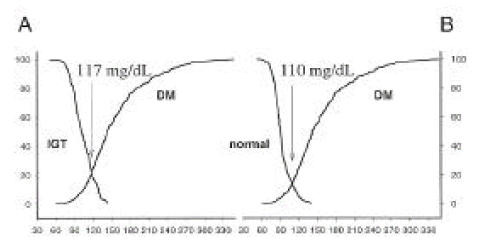
Cumulative frequency distribution curves. A:comparison of IGT and DM group. B:comparison of normal and DM group.
All subjects were also categorized according to 1997 ADA criteria. The numbers of subjects categorized according to both criteria are shown in Table 2. The overall κ value was 0.45 (p=0.00), showing only moderate agreement between the two criteria. Based on WHO criteria, the number of diabetes was 458 (56.5 %) but, based on ADA criteria, the number of diabetes was 342 (42.2 %). Of the 458 subjects diagnosed with diabetes according to the WHO criteria, only 317 (69.2 %) were also diagnosed with diabetes according to the ADA criteria. Thus, 141 subjects (30.8 % of 458 subjects) of DM by WHO were not diagnosed by ADA criteria. Of the 141 subjects not diagnosed with diabetes according to ADA criteria, 64 were classified as having normal fasting glucose, 77 were as having impaired fasting glucose. However, only 25 of 342 (7.3 %) subjects who were diagnosed with diabetes according to ADA criteria were not diagnosed as having diabetes by the WHO criteria.
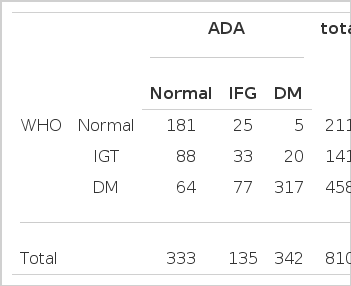
Categorization of subjects according to glucose tolerances tatus by WHO and ADA criteria in Korean subjects
Of total 810 subjects, 135 (16.7 %) were classified as having IFG by using the ADA criteria. Similarly, 141 (17.4 %) were classified as having IGT by WHO criteria.
Glycemic parameters and some phenotypic parameters were compared within concordant normal subjects, both discordant categories and concordant diabetic subjects. The concordant diabetic subjects showed significant higher age, HbA1c, FBG, 2-h BG, total cholesterol and triglyceride values compared with the concordant normal subject. However, the area under the insulin curve and insulinogenic index values were significanly lower for concordant diabetic subjects compared with concordant normal subjects. Similarly, the discordant group, classified as having DM or IGT subjects by WHO criteria but normal by ADA criteria, showed higher age, HbA1c, 2-h BG values and lower insulinogenic index value than concordant normal subjects. Compared with concordant DM subjects, however, the area under the insulin curve and insulinogenic index values were preserved. The discordant group, classified as normal by WHO criteria and as having IFG or DM by ADA criteria showed similar characteristics to the concordant normal subjects, except for age and – as a consequence of the definition – FBG. Especially, the insulinogenic index value of this group was even higher than the concordant normal group (Table 3).

Glycemic parameters and various clinical profiles in concordant and discordant diabetic subgroups according to the WHO criteria and 1997 ADA criteria
Among discordant categories, subjects diagnosed as having diabetes by WHO criteria but normal by ADA criteria were compared with concordant categories. The number of discordant categories normal by WHO and DM by ADA was so small (n=5) that this group were not included in statistical analysis. BMI, sex ratio, baseline insulin level, triglyceride and HDL-cholesterol level were not significantly different between groups. But the subjects categorized DM by WHO criteria but normal by ADA criteria showed older age, higher HbA1c level and significantly lower insulinogenic index than concordant normal subjects. That is, the subjects with normal FBG but abnormal 2-h BG showed similar clinical characteristics of concordant DM subjects (Table 4, Figure 2).
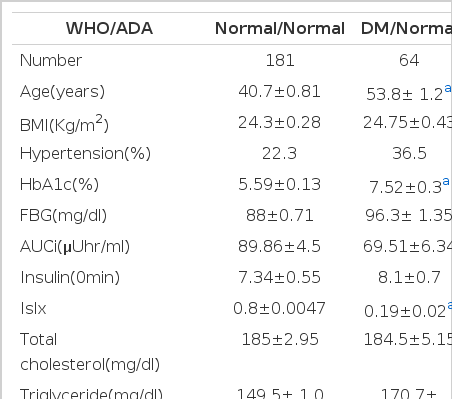
Clinical characteristics of subjects with discordant diagnos is by both criteria: WHO/ADA compared with concordant normal subjects
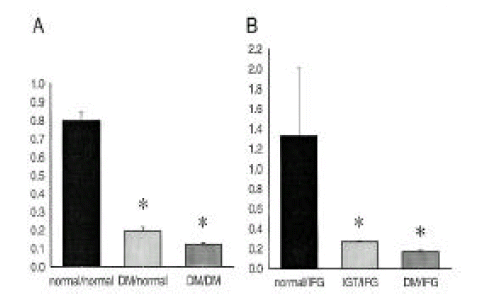
Insulinogenic index of concordant and discordant subgroups according to the WHO criteria and the ADA criteria. A:*p<0.05 vs. concordant normal/normal subjects, B:*p<0.05 vs. discordant normal/IFG subjects
The glucose responses after oral glucose load in this discordant DM/normal group were higher than concordant normal group but lower than concordant DM group. Insulin, especially early insulin response, in this group was significantly lower than that of concordant normal subjects but greater than that of concordant DM subjects. Later insulin responses at 90 min, 120 min were preserved (Figure 3).
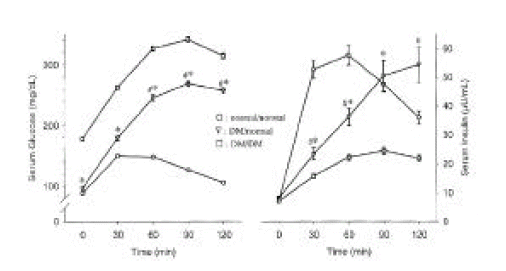
Blood glucose and insulin responses of concordant and discordant subgroups according to the WHO criteria and the ADA criteria during the 75-g OGTT. Values are expressed as means±SEM; # p<0.05 vs. concodant normal/ normal subjects; *p<0.05 vs. concordant DM/DM subjects.
In the intermediate group, IFG, concordant IGT/ IFG group showed significantly lower FBG (115.7±0.67 mg/dL vs 118± 10.52 mg/dL) and HbA1c (6.54±0.22 % vs 7.4±0.23 %) values compare with discordant DM/IFG group. However, the insulinogenic index of concordant IGT/IFG group was significantly lower than discordant normal/ IFG group (0.27±0.07 vs 1.33±0.67) but was not different from discordant DM/IFG group (insulinogenic index, 0.17±0.02) (Figure 3).
DISCUSSION
In this retrospective study, we analyzed the consequences of using the 1997 ADA FPG criteria as an alternative of the 1985 WHO criteria with respect to the prevalence of glucose intolerance in the same population, including mild diabetic subjects and suspected diabetes.
In 1997, in expectation of similar results as when using 1985 WHO criteria, the ADA lowered FPG threshold for diagnosing diabetes to 7.0 mmol/L in order to avoid discrepancy of FPG and 2-h PG and to facilitate the use of FPG as a simpler test than OGTT5).
Actually, this study demonstrated that the FPG cutoff value separating normal and diabetes was 110 mg/dL and that for IGT and diabetes was 117 mg/dL by cumulative distribution curve analysis (Figure 1). We calculated sensitivity and specificity for diagnosing diabetes with each fasting blood glucose value (data was not shown). The sensitivity was 86.0 and 79.5%, the specificity was 76.4 and 86.4% for the 110 and 117 mg/dL cutpoints respectively. These results were comparable to those of 126 and 140 mg/dL criteria: the sensitivity was 69.2 and 55.7%, the specificity was 92.9 and 98.9% respectively. According to this, although this results could not be extended to the general population, many Korean diabetic patients diagnosed by the WHO criteria whose FPG values are relatively low may be missed even though we use the new, lower ADA FPG criteria unless OGTT is performed. These results are similar to the study of newly diagnosed Japanese diabetic subjects by Tanaka et al.6).
Furthermore, in our study, the agreement between the ADA criteria and the WHO criteria was moderate, as reflected in the overallκ of 0.45 (Table 2). In this study, 30.8% of the subjects diagnosed as having diabetes by the WHO criteria were classified as either IFG or NFG by the ADA criteria. However, only 7.3% of the subjects diagnosed as having diabetes according to the ADA criteria were not diagnosed by the WHO criteria. Harris et al., in the third National Health and Nutrition Examination Survey (NHANES III), concluded that a greater proportion of people with undiagnosed diabetes in the US population might be detected using the new ADA criteria in clinical practice11). However, in the NHANES III study population, the prevalence of undiagnosed diabetes was 4.4 % by the ADA criteria and 6.4 % by the WHO criteria and many subjects were differently diagnosed by the two criteria. De Vegt et al. also showed poor agreement between the ADA and the WHO criteria in the Hoorn study13). Although the prevalence of diabetes was similar for both sets of criteria, a substantial number of all subjects shifted between categories in the Hoorn study. In our result, however, the number of diabetic subjects according to the ADA criteria was much less than that of according to the WHO criteria. In the intermediate group, IGT or IFG, a number of subjects were also shifted between categories. Although our study result could not expand to the general population because the study population was composed of various categories including previously diagnosed diabetic subjects, two diagnostic criteria for the same disease with mederate agreement of diagnosis in the same people may have to be reconsidered.
We compared clinical characteristics of discordant subjects with concordant normal or concordant DM subjects in this study. Subjects who had relatively low fasting blood glucose and higher blood glucose level after oral glucose load showed older age, higher HbA1c level and lower insulinogenic index level than concordant normal subjects (Table 3, 4). Other cardiovascular risk factors, such as hypertension, total cholesterol level, triglyceride level and HDL-cholesterol level were not significantly different between the groups. That is, subjects diagnosed as having diabetes by the WHO criteria but normal by the ADA FPG criteria were more aged people and showed lower early insulin response to oral glucose load than concordant normal subjects.
Aging was considered as one of the independent risk factors for glucose intolerance and this glucose intolerance was seen to be partly due to alteration of pancreatic beta cell function-maybe decreased insulin secretion response to the glucose load16).
Wahl et al. found that, among elderly individuals, there was a significant difference in the prevalence of diabetes identified by the WHO diagnostic criteria based on oral glucose tolerance test and the ADA fasting criteria. The mean age was 73 years. In their study, the κ statistic was 0.275, showing poor agreement between the two classification criteria. The prevalence of new diabetes was 7.7% with ADA fasting criteria but 14.8% with WHO criteria. Similarly, for IFG the prevalence with ADA criteria was 14.6%, which was less than half the 32.1% prevalence of IGT with WHO criteria17).
A follow-up study of impaired glucose tolerance showed that low acute phase insulin secretion and low insulin sensitivity at baseline were significant predictors of progression to NIDDM18). In a recent follow-up study of non-diabetic Japanese subjects, insulinogenic index-used as a measure of early insulin response-was shown to be a negative predictor of diabetes. Yoshinaga et al. concluded in their study that most cases of diabetes in the Japanese begin with decreased insulin secretion19). It can be concluded that, in the early stage of diabetes, glucose intolerance occurs with decreased early insulin secretion. In our study, subjects categorized as having diabetes only by the WHO criteria-with high 2-hr BG value and relatively low FBG value-showed mild glucose intolerance status and relatively older age and significantly lower insulinogenic index value than normal subjects. The similar profile of insulinogenic index value was shown in IFG group. The subjects with relatively decreased insulin secretion, though they have mild glucose intolerance status now, might eventually become overt diabetic patients with high fasting blood glucose. It is not certain yet if detection of these subjects at relatively earlier stage will benefit prevention of diabetic complications. Population-based prospective studies are needed. However, from the point of view of proper early diagnosis, our data suggest that OGTT, although it is less reproducible than FPG, would be still complementary test to the FPG criteria.
In summary, these results suggest that mild diabetes by the WHO criteria, especially in the elderly, would not be diagnosed as diabetes by the ADA FPG criteria only. Thus, in subjects at high risk for developing diabetes or in the relatively older age group, we should continue using the OGTT until population-based, long-term follow-up studies have been performed.
